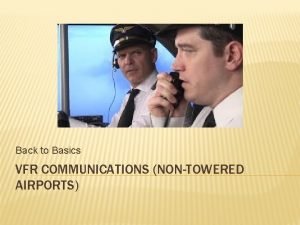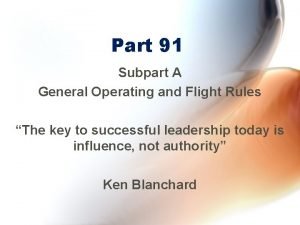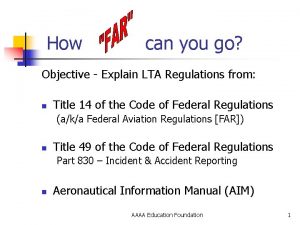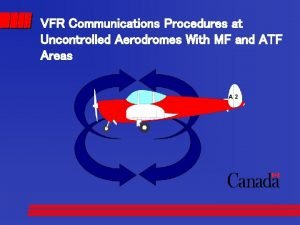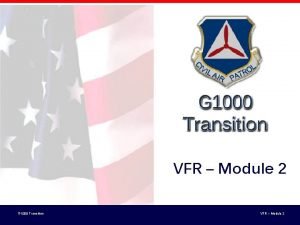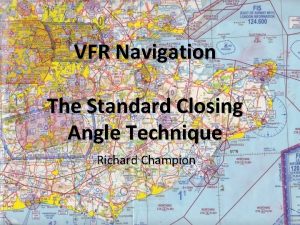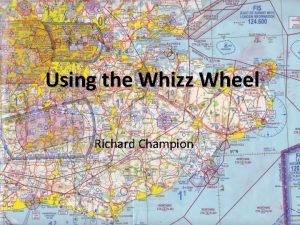VFR Navigation Diverting Richard Champion Aim Diverting To







- Slides: 7

VFR Navigation Diverting Richard Champion

• Aim Diverting – To learn how to to divert to an alternate destination. • Objective – By the end of this briefing, you should be able to use your diversion rule and wind star to plan a diversion to an alternate destination in flight, with the minimum of mental effort. • Airmanship – Good navigation, avoiding airspace busts • Agenda – Equipment needed – How to use it – Examples – Summary

Equipment Required • Wind Star – Pre-calculated adjustments forecast wind. – Allows diversion headings and ground speed to be estimated with the minimum mental effort. • Diversion Rule – Makes it easy to measure distances and estimate arrival times.

How to divert 1. 2. 3. 4. Mark current position on chart. Loiter if necessary. Mark diversion destination on chart. Draw free hand line from present position to diversion destination. Estimate the no wind magnetic heading by comparison to a nearby VOR rose. With practice you will be able to judge this by eye with surprising accuracy. 5. Turn onto heading and note time (or start watch). 6. Interpolate wind correction angle and ground speed from Wind Star. Note on chart. 7. Adjust heading to wind corrected value. 8. Use diversion rule to estimate distance and ETA using ground speed. 9. Fly heading until ETA is up. Do regular FREDA checks. 10. On long diversions, use Standard Closing Angle to correct back to planned track if required.

Example 1 TAS 90 Kts, heading 051°, ETA +32 mins WCA -12 After minutes – actual Lydd position Uckfield Divert 14 - new destination GS 95 Use Calculate wind ETA star. FREDA allowing to estimate for wind time already Fly heading, check, use Standard Use Mark Estimate diversion Uckfield heading rule and to Lydd 100° measure and draw distance line by hand 32 nm, 20 Turn onheading to 100°, start watch Adjust 100° -12° = 088° correction on watch. angle and –track 4 ground = 16 minutes speed Closing if 20 off 350/20 andstop read. Angle off time required. mins

Example 2 TAS 90 Kts, heading 051°, ETA +32 mins Divert - new destination Calculate ETA allowing for use time Use Fly After heading, diversion 14 minutes FREDA rule – to check, actual measure Use wind star to start estimate wind Turn on to 030°, watch Rochester Estimate heading 030° already on stop watch. 22 – 022° 4= distance Standard position and Closing Uckfield read Angle off time if off Adjust heading 030° -8° = correction angle and ground speed Mark Uckfield and Rochester. 18 minutes required. track Draw line by hand WCA -8 GS 75 27 nm, 22 350/20 mins

Summary • We have learned : – How to plot current position, diversion destination and track required. – How to estimate the no wind heading. – How to use the wind star to adjust the no wind heading to allow for the forecast wind. – How to use the wind star to estimate ground speed. – How to use the diversion rule to measure distance and estimate time of arrival at diversion destination. • Always prepare a wind star and take your diversion rule with you on cross countries.




